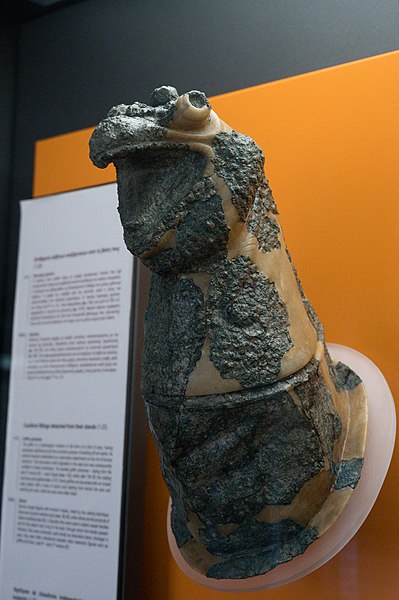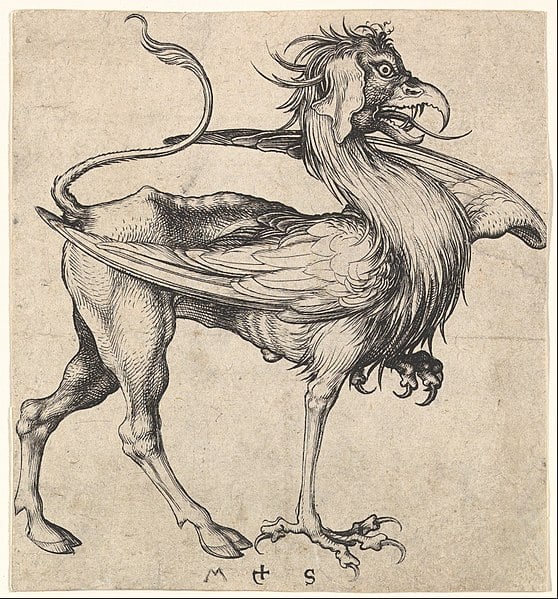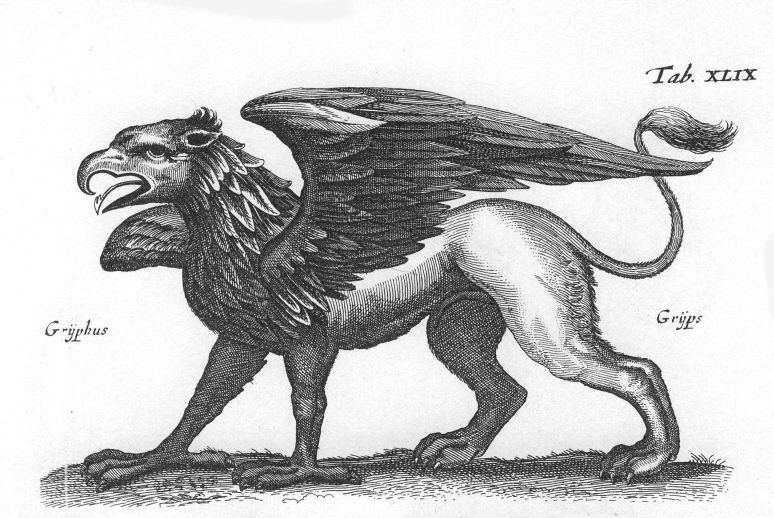Greek mythology is a vast tapestry of tales, interwoven with gods, heroes, and creatures. Among these, the Griffins stand out, not as solitary beings, but as a tribe of majestic creatures, each representing a harmonious blend of terrestrial might and aerial elegance.
Griffins Key Facts
| Origin | Unknown, possibly primordial |
| Creator | None (Natural beings of myth) |
| Habitat | Mountains and remote regions |
| Other names | Gryphus, Gryps |
| Roman name | Gryphus |
| Associated with | Apollo, guarding treasures |
| Symbols | Eagle’s wings, lion’s body |
Name and Etymology
The term “Griffin” is often interchanged with “Gryphon” or “Gryphus” in various chronicles. Originating from the Greek “gryps,” it alludes to the creature’s curved or hooked beak, reminiscent of an eagle. The Romans, too, held these creatures in high regard, referring to them as “Gryphus.” Throughout history, various titles and epithets have celebrated the Griffins, each echoing a different aspect of their nature or their role in myths.

Griffins Origin and Creation
Griffins, unlike many mythical creatures, don’t have a singular origin story rooted in a specific myth or tale. Instead, their existence seems to be an integral part of the world’s fabric since time immemorial. Their primary role as guardians of treasures and sacred realms is deeply intertwined with their nature and symbolism.
The Griffin’s association with the sun, particularly evident in their eagle component, suggests a divine or celestial origin. Eagles, revered in various cultures, symbolize the sun due to their ability to soar high and their keen eyesight that seems to “stare into the sun.” This solar symbolism aligns with the Griffin’s role as a protector of divine treasures. Just as the sun illuminates and nurtures the earth, Griffins, with their solar attributes, watch over and protect the treasures of the gods.
Furthermore, their guardianship extends beyond mere treasures. Griffins are often linked with sacred sites, especially those associated with Apollo, the sun god. Temples, altars, and other places of worship were considered sanctuaries in ancient Greece. The Griffin, with its vigilant nature, was seen as a symbolic guardian of these holy places. Their fierce demeanor and majestic presence served as a deterrent to those who might wish to desecrate these sacred spaces.
In essence, the Griffin’s origin is a harmonious blend of terrestrial might and celestial grace. They might not have a creator god or a specific myth detailing their birth. However, their consistent portrayal across tales and artworks suggests a deep-rooted belief in their existence and significance in the ancient world.
Depiction And Characteristics
Griffins are consistently portrayed as magnificent beings, boasting the body of a lion coupled with the head and wings of an eagle. This duality symbolizes mastery over both earth and sky. Their large, outstretched wings suggest a readiness to soar, while their vigilant eagle eyes are ever watchful. The lion’s robust physique embodies strength and valor, reinforcing their reputation as formidable guardians.
Griffins Nature and Abilities
Greek tales depict Griffins as noble and fiercely protective creatures. They don’t act malevolently but dutifully guard sacred treasures. A touching part of Griffin lore highlights their unwavering loyalty to their partners. People believe that Griffins mate for life, and when one dies, the other stays solitary, never seeking another companion.
Beyond their physical might, Griffins are attributed with exceptional eyesight, rivaling even the keenest eagles. This keen vision allows them to detect intruders from vast distances. Their mighty wings grant them swift mobility, and their lion-like strength renders them nearly invincible in combat. Some legends even whisper of the Griffin’s screech. It was a sound so piercing it could disorient or even immobilize those who dared to listen.
Griffins Symbols
Griffins are intrinsically linked to Apollo, often depicted guarding his treasures and sacred sites. Their dual nature, merging lion and eagle, signifies the sun and the heavens, realms overseen by Apollo. Moreover, their association with gold isn’t merely due to their guardianship of golden mountains. It is said that their very feathers are believed to shimmer like the precious metal, mirroring their divine essence.
Myths about Griffins
Griffins, with their majestic combination of the lion’s body and the eagle’s head and wings, have been a part of various mythologies, but their most notable tales come from Greek legends.
Griffin and Arimaspians: A Battle for Gold
The conflict between Griffins and the Arimaspians is a tale as old as time. Rooted in the vast gold deposits of Central Asia, this myth paints a vivid picture of the Griffins as fierce guardians of these treasures. The Arimaspians, a tribe of one-eyed people, were said to be in constant conflict with the Griffins, attempting to steal the gold that the Griffins so diligently protected.
The earliest classical writings about this conflict come from Aristeas of Proconnesus, a 7th-century BC Greek poet. His accounts, preserved by historians like Herodotus and Aeschylus from the 5th century BC, describe the Griffins as sharp-beaked creatures. However, their portrayal as “unbarking hounds of Zeus” led to speculations that they might have been perceived as wingless in these early tales.
The root cause of the conflict was the immense value and allure of gold. In ancient times, gold was not just a symbol of wealth but also of power and divinity. The Griffins, being part divine themselves, were seen as the rightful guardians of this precious metal. The Arimaspians, on the other hand, driven by their desire and perhaps necessity, constantly tried to raid these treasures, leading to epic battles.
This conflict wasn’t just a simple tale of good versus evil or guardians versus thieves. It symbolized the eternal struggle between the wild, untamed forces of nature (Griffins) and the ambitions of mankind (Arimaspians). The gold, in this context, can be seen as nature’s bounty. Moreover, the story serves as a reminder of the consequences of overreaching one’s boundaries.
Representations Of Griffins In Art
Griffins, with their blend of the lion and eagle, have been a favorite subject in art forms across different cultures. In ancient Crete, during the MM III Period (1650–1600 BC) in Minoan chronology, Griffins were found on sealings from Zakro and miniature frescos. One early example of Griffin-types in Minoan art occurs in the 15th century BC frescoes in the Palace of Knossos, as restored by Sir Arthur Evans.
By the Late Bronze Age, the Griffin had become a fixture of Aegean culture. However, it wasn’t until around 700 BC that the Griffin began to prominently appear in Greek art, adapting the style of Griffin current in Neo-Hittite art. Archaeologists unearthed Bronze Griffin protomes on cauldrons in Greece, especially on Samos and at Olympia. The early Greek and Etruscan cauldron-Griffins might have drawn influence from Syric-Urartian art, as the “tendrils” or “tresses” motif suggests.
Mentions in Ancient Texts
Various ancient texts mention Griffins, often linking their lore to the gold deposits of Central Asia. Aristeas first wrote about Griffins in the 7th century BC. Later, historians like Herodotus and Aeschylus preserved these accounts in their writings from the mid 5th century BC.

Aristeas: The Journey to the Altai
Aristeas of Proconnesus, a Greek from the 7th century BC, traveled to the Altai region between Mongolia and NW China. Although his original poem has been lost, tales of the Griffin was preserved in secondhand accounts by Aeschylus and Herodotus. Aristeas described Griffins as guardians of gold, emphasizing their conflict with the one-eyed Arimaspians who sought to steal this treasure.
Herodotus: Histories
Herodotus, the renowned historian from the 5th century BC, relayed the tales of Aristeas in his work “Histories.” He elaborated on the Griffin’s role as protectors of gold and their ongoing battles with the Arimaspians. A notable passage from Herodotus reads: “The gold-guarding griffins supposedly dwelled further north from the one-eyed Arimaspi people who robbed the gold from these fabulous creatures.”
Pliny the Elder: Natural History
Pliny the Elder, in his encyclopedic work “Natural History” from the 1st century AD, provided a more detailed account of Griffins. He was the first to explicitly describe them as winged creatures with long ears. Pliny also mentioned the lore of Griffins guarding gold deposits in Central Asia.
Aelian: On the Characteristics of Animals
Claudius Aelianus, commonly known as Aelian, wrote “On the Characteristics of Animals” in the 3rd century AD. In this work, he described Griffins in detail, blending attributes of the Griffin with those of gold-collecting ants from India. Aelian’s account is particularly notable for its vivid descriptions, such as the Griffin’s “black plumage on its back with a red chest and white wings.”
Pomponius Mela: De Chorographia
Pomponius Mela, a Roman geographer from the 1st century AD, wrote “De Chorographia.” In this work, he described the Griffin-inhabited regions near the Riphaean Mountains, emphasizing the creature’s fierce nature and their role as guardians of gold.
Frequently Asked Questions
Griffins epitomize mastery over both land and sky, embodying strength, protection, and grandeur.
They inhabited mountains and secluded terrains, zealously guarding treasures and sacred locales.
They are closely tied to Apollo, often seen safeguarding his treasures and sacred territories.
No, they are noble guardians, shielding treasures and sacred places from intruders.
The Arimaspians, a tribe of one-eyed men, frequently battled with Griffins over gold.
Featured Image Credit: Matthius Merian, Public domain, via Wikimedia Commons

